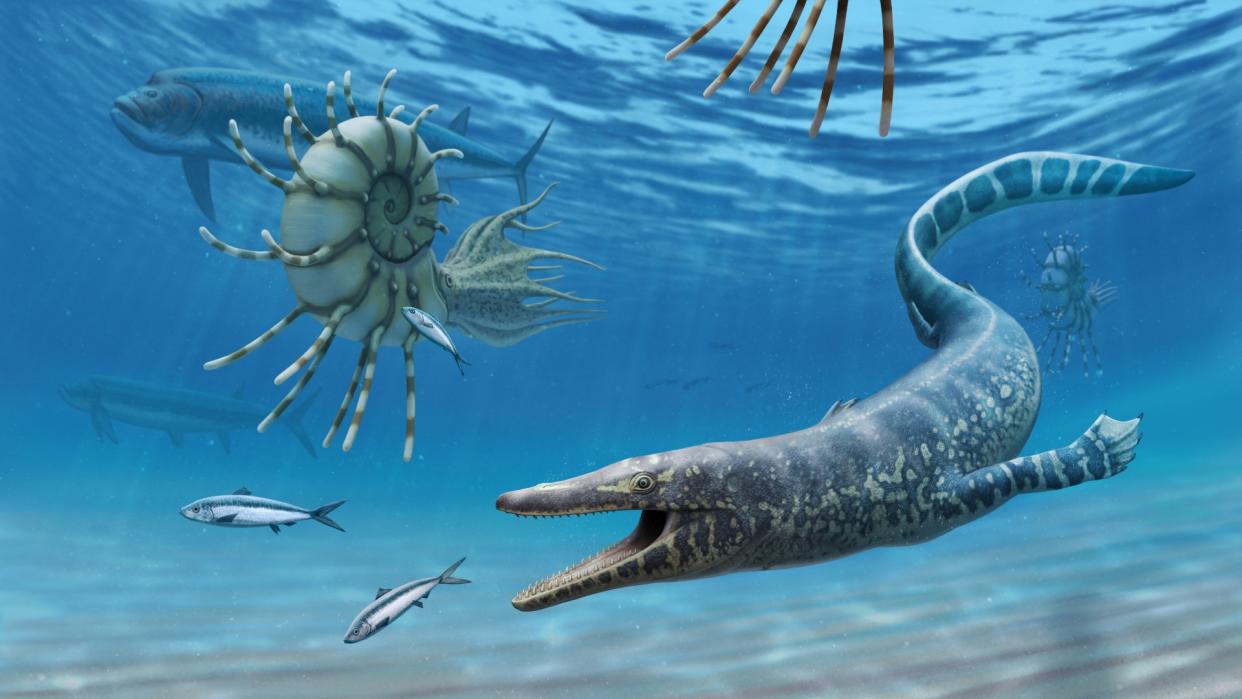94 million-year-old fossilized sea monster is the oldest of its kind in North America

In the rocky gray shale of southern Utah, scientists have unearthed the remains of a mosasaur that roamed a once-thriving sea 94 million years ago. The toothy reptilian is a never-before-seen species and the oldest mosasaur fossil ever found in North America, according to a new study published Monday (June 26) in the journal Cretaceous Research.
Mosasaurs were a group of marine reptiles that dominated the seas during the Cretaceous period (145 million to 66 million years ago). At that time, this region of Utah was part of the Western Interior Seaway — an ancient sea that stretched from the Gulf of Mexico to the Arctic Circle and split what is now North America in two.
Living at the same time as dinosaurs, many mosasaurs had long tails and paddle-like appendages to chase after prey. Some individuals likely grew as large as 56 feet (17 meters) long, according to a 2014 study in the journal Proceedings of the Zoological Institute RAS.
The newly described species was likely only around 10 feet (3 m) long, the researchers estimated.
Related: An 18-foot-long sea monster ruled the ancient ocean that once covered Kansas
"During the time the Tropic Shale was being deposited, about 94 million years ago, mosasaurs were still very small, primitive, and in the early evolutionary stages of becoming fully marine adapted," said study co-author Barry Albright, a paleontologist at the University of North Florida, in a statement. "For these reasons, their fossils are extremely rare and difficult to find."
The scientists uncovered the first fragment of the mosasaur's fossil in 2012, then spent the next two field seasons recovering nearly half of the individual, which eventually allowed them to categorize it as a new species.
The fossil was found in multiple pieces and had weathered on the surface for many years, study lead author Michael Polcyn, a paleontologist at the Southern Methodist University in Texas and Utrecht University in the Netherlands, told Live Science in an email. "So it was not in pristine condition... [It] took a lot of detailed comparisons to work out all of the anatomy and understand its relationships."
They named the new species Sarabosaurus dahli — which translates to "lizard of the desert mirage" — in honor of one of the team's volunteers, Steve Dahl, and as an "homage to the mirages often seen in the hot Tropic Shale badlands in the summer," the researchers wrote in the study.
Early mosasaur species resembled lizards in appearance, and still had relatively primitive limbs when compared to later mosasaur species, which would rule the seas with their streamlined bodies, the researchers said. However, S. dahli differed from other early forms of mosasaurs in how it circulated blood to its brain, which may have helped it become better adapted to the marine environment, the research found.
RELATED STORIES
—'Merciless' sea monster with broken teeth prowled the seas 66 million years ago
—Mini sea monster had teeth as sharp as a saw blade
—This ancient sea monster could do the breaststroke
"It may possibly be related to countering effects of deep or long duration diving in this group," Polcyn said.
The team said S. dahli provides a better understanding of mosasaur evolution. "The discovery shows the timing of the branching of major divisions (subfamilies) of mosasaurs was much earlier than previously thought," Polcyn said.
Editor's note: Updated at 12:51 p.m. EDT to note that the newfound mosasaur is about 10 feet (3 meters) long, not 3 feet (1 m) as was previously mentioned.

